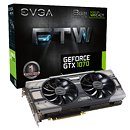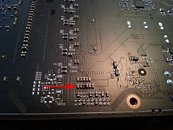Raevenlord
News Editor
- Joined
- Aug 12, 2016
- Messages
- 3,755 (1.19/day)
- Location
- Portugal
| System Name | The Ryzening |
|---|---|
| Processor | AMD Ryzen 9 5900X |
| Motherboard | MSI X570 MAG TOMAHAWK |
| Cooling | Lian Li Galahad 360mm AIO |
| Memory | 32 GB G.Skill Trident Z F4-3733 (4x 8 GB) |
| Video Card(s) | Gigabyte RTX 3070 Ti |
| Storage | Boot: Transcend MTE220S 2TB, Kintson A2000 1TB, Seagate Firewolf Pro 14 TB |
| Display(s) | Acer Nitro VG270UP (1440p 144 Hz IPS) |
| Case | Lian Li O11DX Dynamic White |
| Audio Device(s) | iFi Audio Zen DAC |
| Power Supply | Seasonic Focus+ 750 W |
| Mouse | Cooler Master Masterkeys Lite L |
| Keyboard | Cooler Master Masterkeys Lite L |
| Software | Windows 10 x64 |
After users' reports (and Tom's Hardware.de testing) of EVGA FTW 1080 and 1070 cards displaying black screen issues, and sometimes even sparking and dying altogether, even at stock voltage, the company is now moving towards fixing the issue.
Apparently, the issue stems from the absence of any thermal pads over the VRM area of the FTW line of cards, which prompts higher operating temperatures. Some users were reporting heat transfer in such quantities that even the GDDR5X memory chips on the cards were being heated at 107 ºC, significantly over their rated operating temperatures of (0°C ≤ TC ≤ +95°C).



In a blog post on EVGA's forums, a company representative issued the following message:
"The test used in the referenced review from Toms Hardware (Germany) is running under Furmark, an extreme usage case, as most overclockers know. We believe this is a good approach to have some idea about the graphics card limit, and the thermal performance under the worst case scenario. EVGA has performed a similar qualification test during the design process, at a higher ambient temperature (30C in chamber) with a thermal coupler probe directly contacting the key components and after the Toms Hardware (Germany) review, we have retested this again. The results in both tests show the temperature of PWM and memory is within the spec tolerance under the same stress test, and is working as originally designed with no issues.
With this being said, EVGA understands that lower temperatures are preferred by reviewers and customers.
During our recent testing, we have applied additional thermal pads between the backplate and the PCB and between the baseplate and the heatsink fins, with the results shown below. We will offer these optional thermal pads free of charge to EVGA owners who want to have a lower temperature. These thermal pads will be ready soon; and customers can request them on Monday, October 24th, 2016. Also, we will work with Toms Hardware to do a retest."
EVGA stresses that according to their own internal testing, no overheating issues are present in the card by using it as is (i.e., without the thermal pads), and that there won't exist any long term effects on using the cards such as they are. The company reiterates that their offer stands only inasmuch as some of EVGA's users want lower temperatures specifically on the referred cards' VRM and memory, with the usage of the thermal pads not being required to achieve normal operation. In a statement, the company has also attributed the black screen issues towards an "out of spec On Semiconductor component" that affected only 3-4% of EVGA's GTX 1080 FTW/HYBRID, with these issues "not [being] related to temperatures in any way" having been fixed as of September 1st, with the company having already sent replacements where applicable.
The thermal pads will be provided to anyone with a GTX 1080 or GTX 1070 with an ACX cooler and a backplate, with other graphics card models from EVGA's models also being considered for the offer. While EVGA is surely going about the problem in the correct manner, it still leaves to customers the responsibility of dismantling their EVGA cards and applying the thermal pads on their own. Bellow is an image posted by EVGA showing the temperature results of a GTX 1080 FTW with the thermal pad solution.

View at TechPowerUp Main Site
Apparently, the issue stems from the absence of any thermal pads over the VRM area of the FTW line of cards, which prompts higher operating temperatures. Some users were reporting heat transfer in such quantities that even the GDDR5X memory chips on the cards were being heated at 107 ºC, significantly over their rated operating temperatures of (0°C ≤ TC ≤ +95°C).



In a blog post on EVGA's forums, a company representative issued the following message:
"The test used in the referenced review from Toms Hardware (Germany) is running under Furmark, an extreme usage case, as most overclockers know. We believe this is a good approach to have some idea about the graphics card limit, and the thermal performance under the worst case scenario. EVGA has performed a similar qualification test during the design process, at a higher ambient temperature (30C in chamber) with a thermal coupler probe directly contacting the key components and after the Toms Hardware (Germany) review, we have retested this again. The results in both tests show the temperature of PWM and memory is within the spec tolerance under the same stress test, and is working as originally designed with no issues.
With this being said, EVGA understands that lower temperatures are preferred by reviewers and customers.
During our recent testing, we have applied additional thermal pads between the backplate and the PCB and between the baseplate and the heatsink fins, with the results shown below. We will offer these optional thermal pads free of charge to EVGA owners who want to have a lower temperature. These thermal pads will be ready soon; and customers can request them on Monday, October 24th, 2016. Also, we will work with Toms Hardware to do a retest."
EVGA stresses that according to their own internal testing, no overheating issues are present in the card by using it as is (i.e., without the thermal pads), and that there won't exist any long term effects on using the cards such as they are. The company reiterates that their offer stands only inasmuch as some of EVGA's users want lower temperatures specifically on the referred cards' VRM and memory, with the usage of the thermal pads not being required to achieve normal operation. In a statement, the company has also attributed the black screen issues towards an "out of spec On Semiconductor component" that affected only 3-4% of EVGA's GTX 1080 FTW/HYBRID, with these issues "not [being] related to temperatures in any way" having been fixed as of September 1st, with the company having already sent replacements where applicable.
The thermal pads will be provided to anyone with a GTX 1080 or GTX 1070 with an ACX cooler and a backplate, with other graphics card models from EVGA's models also being considered for the offer. While EVGA is surely going about the problem in the correct manner, it still leaves to customers the responsibility of dismantling their EVGA cards and applying the thermal pads on their own. Bellow is an image posted by EVGA showing the temperature results of a GTX 1080 FTW with the thermal pad solution.

View at TechPowerUp Main Site
Last edited:





